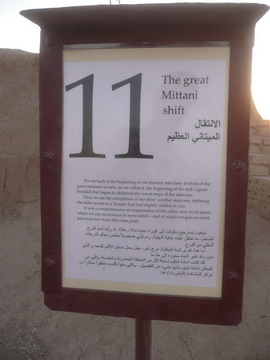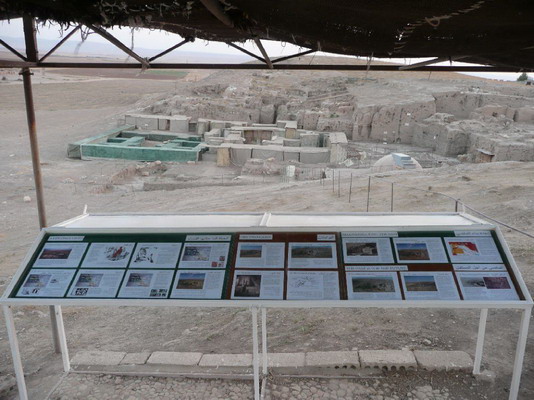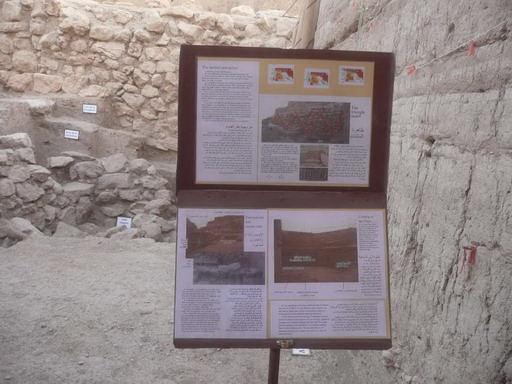Back to top: The signage system
Physical appearance
The physical appearance of the signs offers many options. I have deliberately avoided the one that is generally followed when signs are posted at all: beautifully produced panels, that are however expensive and sometimes imported from abroad. They are difficult to replace, they do not allow the insertion of photographs, and because of costs they have to be kept to a minimum.
I have chosen instead display techniques that are simple, at home in the local context, and inexpensive – but, I trust, sufficiently attractive to appeal to the visitor. For certain, they offer the means to provide a maximum of information, in the most articulate and diversified format, and with an inexhaustible opportunity for updates.
We are, and will continue to be, experimenting with various solutions to external problems such as the weather or the occasional vandalism. And we are at the same time listening to the comments of our visitors to include what we think is most valuable of their experience as well.
Back to top: The signage system
Panels and pages
The term “panel” refers to the physical object that is used to display one or more pages. There are three types of panels.
A “page” is a physical page in format A4. Signposts and some reading stands consists of only one page, whereas the “panoramas” and most reading stands consist of several.
Back to top: The signage system
The three types of panels
There are three tiers of signs, where the physical difference is matched by the functional difference. In other words, the physical design matches closely the conceptual design. Here I give an overview of the outward characteristics of each of the three tiers.
| Signposts. – These are single panels that describe in a few words the nature of a stop along the way. They are inscribed with a large number that helps identify the stop from some distance. Together, they constitute the full itinerary that is proposed to the visitor. | 
|
| "Panoramas". – The term is used in local parlance to refer to the structure from which one looks at the excavations. Here we have placed permanent shades that allow the visitor to take in a broad view of selected areas, and large panels that include a number of pages, arranged in various thematic groups. |

|
| Reading stands. – These are placed at specific junctures within the excavations, facing the feature they illustrate. For the most part, they contain four pages plus smaller insets, although a few reading stands have only one page (like the signposts). I call them "reading stands" because of their look, similar to that of the stands used for playing music instruments. | 
|
As of 2009, the entire system of signs includes a total of 161 full pages, all given in English and in Arabic. The translation of all signs into Arabic is by Rasha Endari with the assistance of Yasmine Mahmoud.
Back to top: The signage system
Conceptual design
The physical distinctiveness of the signs is matched by that of the overall conceptual design, which, in effect, represents the narrative proposed to the visitor. Different levels of interest are assumed, and it is to each of these that the three tiers refer.
All are integrated into a single, interlaced whole that aims not only for internal coherence, but also for a graduated appeal that favors easy transitions from one level to the next.
Back to top: The signage system
1. Signposts
The signposts punctuate the main stops along the way. They are “signposts” because they serve to indicate, with their large printed number, the location of the stop, and to describe in a few words the nature of what visitors are seeing. They serve a double function.
On the one hand, they define the itinerary in its narrative sequence. The titles and the brief texts explain how the story line unfolds, and links are highlighted from one to the other.
On the other, they provide the hurried visitors with the essential information that can be absorbed and retained during a half hour visit, while at the same time enticing them to return with the expectation of a fuller fruition through the other signs posted within each stop.
The complete series is given in the page on narrative.
Back to top: The signage system
2. “Panoramas”
The “panoramas” offer a synthetic overview and afford the opportunity to reflect on important broader implications. The term “panorama” is used in local parlance to refer to the structure from which one looks at the excavations. They are placed high on artificial knolls, and thus serve as overall vista points from which to survey broad portions of the archaeological landscape.
At these locations we have placed permanent shades that allow the visitor to take in a broad view of selected areas, and to reflect on important implications.
The location high above the ground level of the ancient monuments facilitates these moments of synthesis and reflection. It allows to see broad connections among elements of the architecture and the stratigraphy, which may be too foreshortened on the ground so as to result in a myopically limited view. These larger vistas are thus meant to facilitate our view of the historical unfolding which is inscribed in the monuments, rather than to bring us down to their level, where we would seek to recreate the ancient perception. This task is reserved to the reading stands.
As of 2009, two “panoramas” are housed in two kiosks that overlook the Temple and the Palace, respectively. A knoll has been prepared for a third “panorama,” set between Temple and Palace, which will present a view of the link between the two.
We expect these “panoramas” to remain in the present shape and location for a number of years to come, although the design is so conceived as to allow the relatively easy replacement of the individual plates.
One will find details on the two kiosk set-ups and the full text of all the plates exhibited in the treatment of stations 2 (Temple) and 6 (Palace).
Back to top: The signage system
3. Reading stands
Function
Like footnotes in a text, the reading stands develop more fully certain points of detail, answer questions on the part of a visiting archaeologist, stimulate the curiosity of the intelligent visitor. They provide important additional detail, but can be read or skipped depending on interest and time availability.
For casual visitors, they anticipate questions, stimulate latent interests and direct the attention to points of detail. Even a visitor in a rush knows that something deserves more reflection, and the very availability of the information encourages further thoughtful and unhurried visits.
For interested visitors, the “footnotes” offer the possibility to study the site as one would a book. It is in this sense that conservation and site presentation go hand in hand: what is explained ought to be visible in its original state, as it was when first excavated. Then the site itself is effectively presented in this full documentary power.
As of 2009, there are twenty-six reading stands.
Characteristics
The reading stands are a central component of the Mozan presentation system, because of the following characteristics:
- Flexibility. – Physically, the reading stands are adaptable to any situation in the ground.
- Graduated detail. – Conceptually, they can reflect a number of different types of information and ranges of detail, thereby addressing each audience at its proper level.
- Unobtrusiveness. – Small in size and slight in shape, they are noticeable only for those who want to see them.
- Direct relevance. – Being placed next to the feature they illustrate, the reading stands provide a one on one commentary with an immediate link to the pertinent monument.
Back to top: The signage system